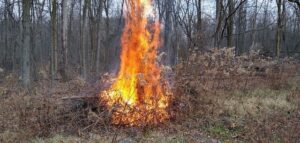Kiss you ash goodbye
Waste Not, Want Not
If you heat with wood at all, by this time of winter, the ash barrels are getting full. The ash bit keeps getting bigger and places to put it get harder to find, especially when the winter was as harsh as this one has been.
Take heart, wood ash is about to become an important input that you will wonder how you ever did without.
Wood ash is the residue of fire, an exothermic oxidation chemical reaction. Carbon in the wood, combines with oxygen to make carbon dioxide and water vapor. Ash is made up of the phosphorus, sulfur and other chemicals that were part of the wood that were let once the carbon oxygen blew away.
So, when you think about it, ash is the most natural fertilizer there can be. It is made up of the stuff that wood was made up of, minus the carbon and oxygen. Why you want to waist this awesome plant food that nature spent decades sticking into logs, branches and leaves? It only makes sense to put it back where it came from so it can make more wood and wildflowers.
Spreading Your Wood Ash
You probably heard the expression, “Too much of a good thing is still too much.” Well, that is true of wood ash. Think of ash as very concentrated plant food. When it combines with water, it can be chemically quite potent. That reaction can product an alkaline broth that in too concentrated a form, may chemically “burn” your plants. The trick is to spread wood ash very lightly on across your property. An inch thick layer on your garden is to damage the very plants you want to feed.
I like to stand at the downwind end of the area where I want to spread wood ash and carefully shake out very small amounts of ash so that the wind catches and disperses the ash in a billowing cloud. Of course, you want to be standing with you back to the wind so that is moving away from you. Walk backward dispersing the ash as you go so that it drifts in a more or less ever and very thin swath. Your should be dusting rather than coating the soil. In that way, a fire gallon bucket of wood ash can fertilize up to 1,000 square feet.
Spread wood ash from brush piles, as well as your fireplace and wood stove. In this way, you can be fertilizing your property all year round.

Brush Piles, Wood Ash and Biochar
Unlike a furnace or fireplace, there is no need to completely burn all the fuel in your brush piles. I like to let the pile burn down until it forms a nice solid bed of coals. At that point, the volume has reduced to a small fraction of the original brush. Those glowing coals, however, still contain plenty of carbon called biochar.
Now is the time to spray down the pile with a hose of even watering can. The object is to stop combustion by turning all the red into black. Ending your brush pile burn here does two things. First, you limit the amount of greenhouse gasses you are putting up into the atmosphere, which is a really good thing. Second, all that carbon locked up in that pile of charcoal is mostly carbon. Why not feed all that carbon, along with the other minerals in the ash to your gardens, woodlands and prairies?
Just as with the wood ash, scatter the charcoal thinly across the land. I usually use a gloved hand and broadcast the charcoal like I was hand sewing seed or hand spreading fertilizer. Of course, you must make certain the charcoal has thoroughly cooled for several days both to protect your hands, and preventing the inadvertent broadcasting of smoldering coals that could tonight a wildfire.
There is more to know about biochar and how it can be used as a super plant food, check out this video. You can also check out my blog post on Great Brush Pile Burning for help making that chore easier and more productive.
Bottom Line
If it sounds like I totally beat a dead horse, you are probably right. The bottom line is that wood ash is not an annoying waste product from your wood stove or brush pile. It is a valued input for your land. As a good land manager, you should be making the best use this wonderful resource. It is free food and who doesn’t like free stuff?

